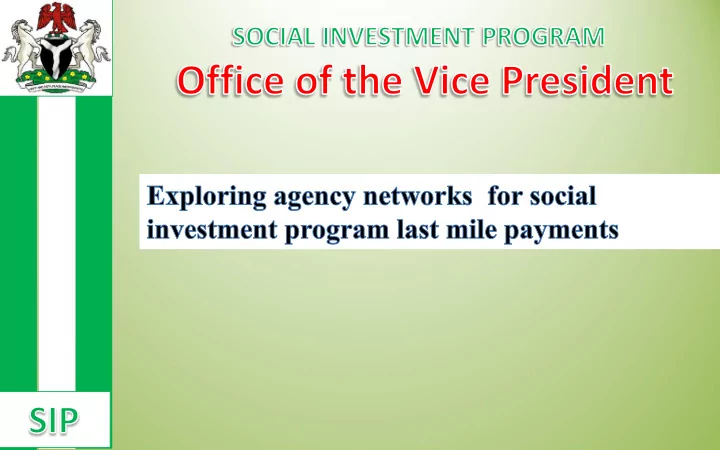

PROGRAM OVERVIEW GEEPS CCT Government Enterprise CONDITIONAL CASH TRANSFER Empowerment Programme HGSF HGSFP National Homegrown School N-POWER Feeding Programme NASCO
– OVERVIEW Ensure we achieve core payment cardinal points of paying the right person, the right amount, the right time at the right cost. Leverage new partnerships to collectively address program challenges and proffer new sustainable solutions. Evaluate current last mile payment challenges and solutions in the market place with considerations for regulatory environment and national standards. Incremental improvements where payment mechanism is currently working. 3
PROGRAM PAYMENT ATTRIBUTES (Not universal to all the clusters) Frequent, low value payments Infrequent high value payments Rural outreaches Limited telecommunications access low literacy rate Low mobile phone ownership Low banking access and availability Poor and vulnerable targets Frequent in-bound payments for loan repayments 4
THE PAYMENT ECOSYSTEM 5 Addressing the last mile challenges of G2P / P2G / P2P outbound and inbound
Current Payment update Actively working with NIBSS, Banks and Mobile Money • operators in some states (Depending on individual program requirements) Clearance of payment backlogs (NCTO) • Working with Bank partners and NIBSS to pay beneficiaries • with access to bank branches, ATM, (NCTO) Development of mobile agents with MMOS • Exploring fixed location agents where sustainable and mobile • agents where fixed agents are not sustainable (Proposed) N-power beneficiaries paid via verified bank account. • School feeding vendors paid via verified bank accounts. • 6
Payment types G2P Government to person (Out-Bound) • NCTO, N-Power, School Feeding, GEEPS. They all receive payments from government as stipends, loans, payments for services etc G2P Government to person (In-bound) • GEEPS beneficiaries repay their loans to government P2P Person to person • School feeding vendors making payments to suppliers in their value chain. 7
AGENCY ECONOMICS Agency acquisition and set up cost Agent churn and redundancies Agency sustainability Liquidity management 8
BALANCING THE ECONOMICS OF PROGRAM & TRANSACTIONAL AGENTS TRANSACTIONAL AGENTS PROGRAM AGENTS frequent transaction and infrequent transactions diverse payments PUSH factor PULL factor Fees paid by program Fees paid by customers owners Clustered demand side Fragmented demand side Diverse products and services Single anchor service Unpredictable transaction Predictable payment circles circles Mobile agents Community based agents 9
SIP – An opportunity for financial inclusion Leverage the scale and reach of the program as financial inclusion entry points for Nigeria. Providing basic communal access for communities in financially excluded communities. Leveraging on monthly stipends, loan disbursements and empowerment funds to drive other financial services like savings, remittances etc Financial education and literacy Provide a boost for mobile money and agency banking operations in Nigeria. 10
The need for a well distributed National agency network Serve as a shared agency pool for last mile payment for all the programs. Accept in-bound repayments for loans Provide alternative means for cashing out even for programs that are strongly linked to bank accounts but with limited bank branches or alternative cash out points. Provide enrollment services where allowed. Provide wallet services Provide agency services in-communities. 11
Working together Evaluate the last mile payment challenges for in-bound and outbound payments. Explore and review areas of compelling needs and partnerships. Evaluate the commercial, technology, regulatory and operational requirements for partnerships. Introduction to program coordinators and streaming engagement plans. Plan a supply-side assessment meeting to review proposals and suggestions. 12
Q & A EMMANUEL OKOEGWALE NCTO 13
Recommend
More recommend